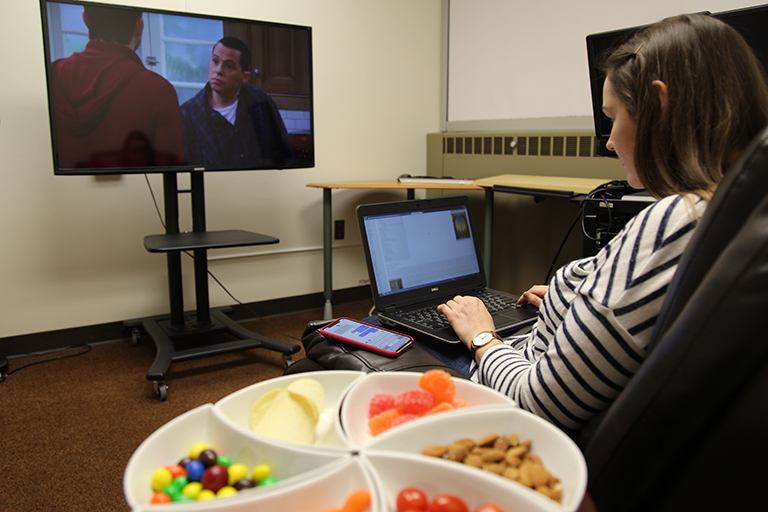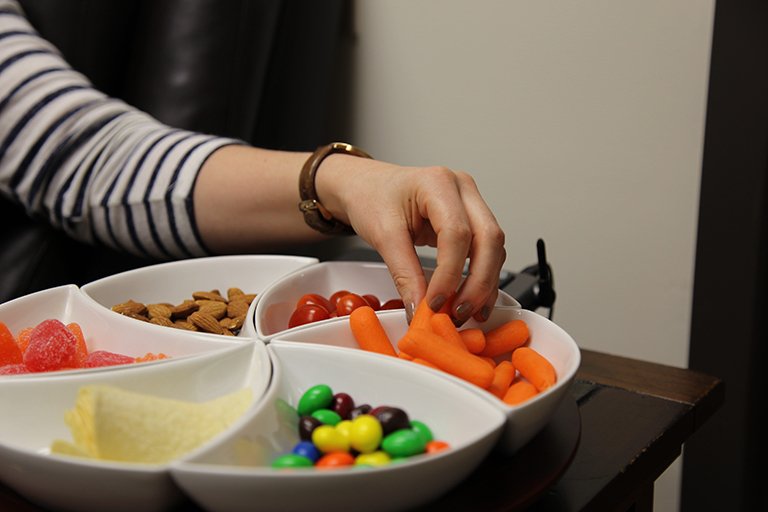Multitasking is a big buzzword these days. If drivers are texting in the car, they’re more likely to get into an accident than those who don’t text. If students are on social media in the classroom, they’re probably not learning the material. If individuals are multitasking at work, they’re more inclined to stress.
“[Multitasking] can be dangerous for your life, it can be dangerous for your learning process and it can be dangerous, apparently, for eating,” said Anastasia Kononova, an assistant professor in the Department of Advertising + PR.
In our heavily tech-based society, it’s nearly impossible to avoid doing more than one thing at a time. As Kononova discovered in her most recent study, this trend of media multitasking can have quite the impact on your snacking behavior. And with the ever-rising rate of obesity, it might make you think twice before trying to watch an episode, write a paper, scroll through Instagram and eat some snacks at the same time.
An Interest in Media Multitasking

Kononova came across the phrase “media multitasking” when she was earning her graduate degree and studying the effects of news stories that depicted minority groups on memory. Her primary argument was that when individuals are distracted by other technology or media content, they don’t pay as much attention to the (non)stereotypical depictions presented in the news. As a result, they make stereotypical impressions of news story characters.
Media multitasking occurs when individuals are switching their attention between multiple media messages or various devices at one time. Kononova found this idea to be both fascinating and concerning, since technology seems to be all-consuming today. She wondered how this habit affects our physical and mental health and has found the perfect environment to study its effects here at ComArtSci.
“I’ve been here for awhile and I absolutely love working in the Department of Advertising + PR — and our college in general — because it’s so interdisciplinary and offers multiple collaboration opportunities,” said Kononova.
Working in ComArtSci’s collaborative environment pushed the researcher to partner with Dr. Anna McAlister, a developmental psychologist whose research focuses on food and beverage marketing and nutrition, and Hyun Jung Oh, then doctoral student in the Information and Media program and now an assistant professor in CHA University in South Korea. The three researchers brought together their specialties and co-authored a study to find out more about media use and snacking behaviors in young adults. They were curious if a higher level of media multitasking would lead to impulse-driven food choices and result in a higher consumption of unhealthy snacks.
“You always think about the different areas in which your research might be significant or impactful,” said Kononova. “Eating habits are very important, especially with the growing rates of obesity.”
The Experiment
Kononova and the research team centered the study on media use to see if adding more screens to one’s environment would cause them to snack a certain way. She hypothesized that people who multitasked with more screens would be more overwhelmed performing multiple media activities, less prone to rationalization and less likely to pick healthy snacks.

“You have the knowledge that you probably have to eat a healthy dinner, maybe a salad,” said Kononova. “But after a long and tiring day, you see cake in the fridge and this is exactly what you indulge in. The proposition of our study was exactly that.”
During the experiment, individual participants were brought into a small room and seated in a comfortable reclining chair. Each participant was assigned to one of four experimental conditions, each of which had a varying degree of multitasking:
Condition I: Watch an episode of “Two and a Half Men.”
Condition II: Watch the episode while responding to text messages received every two minutes.
Condition III: Watch the episode, respond to text messages and read a Wikipedia article about romanticism while taking a 45-question quiz about the information.
Condition IV: Watch the episode, respond to text messages and online shop in a controlled scenario in which you can choose gifts from 20 products for a baby shower.
Only participants in Condition I did not multitask. In each of these conditions, individuals watched the same episode of “Two and a Half Men.” The show itself was an easy choice, as it wasn’t so popular that students would watch it and ignore other tasks, but it also wasn’t so outdated that students wouldn’t watch it at all.
Choosing the episode, however, was harder than one would assume, as Kononova and the team had to ensure that the show did not feature food or drink.
“We made sure that this episode did not facilitate any thoughts about eating or drinking,” said Kononova. “We went through several seasons and we only [found] one or two episodes where people didn’t drink or drank only once and didn’t eat anything. It was very difficult.”
In each of the conditions, a tray of snacks was brought into the room and placed on a table next to the participant’s chair halfway through the half-hour-long episode. The tray included three healthier snacks: cherry tomatoes, raw almonds and carrots, and three less healthy snacks: pizza-flavored Pringles, almond M&Ms and orange slice candies.
The Results
All of the snacks were measured before and after being placed in the room with each participant. They were measured in grams rather than ounces so that even the smallest amount of food taken would be detected. If you ate half an almond, Kononova and the research team would know it.

The researchers were expecting the data to confirm that an increase in multitasking would lead to an increase in the consumption of unhealthy snacks. However, that’s not exactly what they found. The data showed that the connection between multitasking and eating behavior had more to do with whether the multitasking was pleasant than how many screens were being used at once.
“It was only in the negative condition that people did not choose to eat the healthy snacks, which I guess makes sense because maybe it brings us to the discussion of stress,” said Kononova. “[When stressed,] you don’t really want to eat those carrots and the tomatoes and you don’t have any energy to reason with yourself.”
The participants in the first, second and fourth conditions considered media use to be pleasant, and their intake of the healthier snacks reflected that. The third condition, in which participants were asked to read the Wikipedia article, was ultimately the only condition that individuals felt was a negative experience. Participants in this condition were much less likely to pick the healthy snacks.
“The main interpretation is that not any multitasking that makes us tired is unhealthy for us in terms of snack consumption,” said Kononova. “It’s really about multitasking that is unpleasant.”
In other words, if you enjoy multitasking, you’re likely to continue to make healthy decisions, but if performing multiple tasks tend to be overwhelming and stressful, you’re more likely to consume less healthy snacks. So what can you do to make healthy choices while using multiple screens?
“Be mindful when you feel like you’re doing too many things or you’re using too many technologies,” said Kononova. “You realize this can affect your physical health.”
What’s Next?
Now that this study has been completed, Kononova is looking for ways to expand upon her research, and already has a few ideas in mind.
“We wonder, for multiple reasons, if self control can actually explain that type of result,” said Kononova. “I think the next step will be to look at what the strategies are that people implement not to eat unhealthy in a stressful media use situation.”
She also believes that the component of stress and negative emotions plays a large role in her findings. She wants to continue to explore the effects that multimedia multitasking can have on our emotional state.
“This study showed that multitasking by itself is not necessarily a bad thing or, by itself, all that negative,” said Kononova. “One can watch TV, text and shop online and still make right snack choices. I guess it’s not only about multitasking — using multiple screens at the same time — but it’s about using media in general.”
By Kaitlin Dudlets
